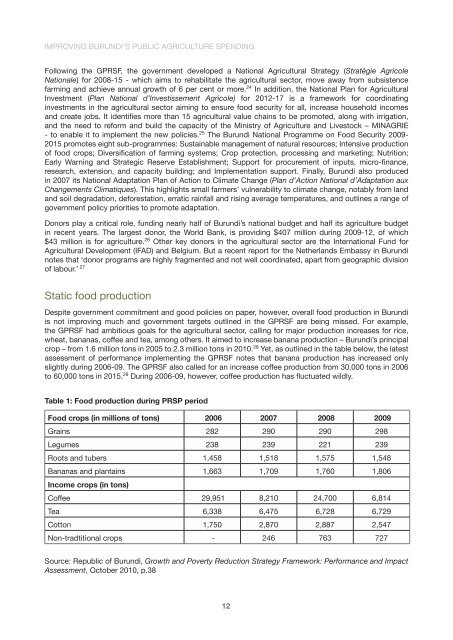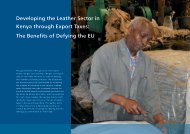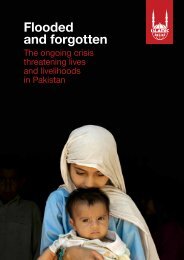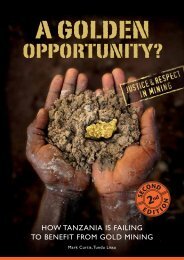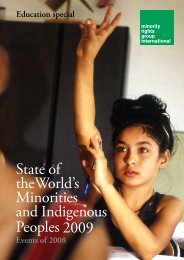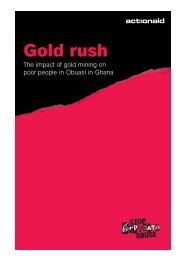IMPROVING AFRICAN AGRICULTURE SPENDING ... - Africa Adapt
IMPROVING AFRICAN AGRICULTURE SPENDING ... - Africa Adapt
IMPROVING AFRICAN AGRICULTURE SPENDING ... - Africa Adapt
Create successful ePaper yourself
Turn your PDF publications into a flip-book with our unique Google optimized e-Paper software.
<strong>IMPROVING</strong> BURUNDI’S PUBLIC <strong>AGRICULTURE</strong> <strong>SPENDING</strong><br />
Following the GPRSF, the government developed a National Agricultural Strategy (Stratégie Agricole<br />
Nationale) for 2008-15 - which aims to rehabilitate the agricultural sector, move away from subsistence<br />
farming and achieve annual growth of 6 per cent or more. 24 In addition, the National Plan for Agricultural<br />
Investment (Plan National d’Investissement Agricole) for 2012-17 is a framework for coordinating<br />
investments in the agricultural sector aiming to ensure food security for all, increase household incomes<br />
and create jobs. It identifies more than 15 agricultural value chains to be promoted, along with irrigation,<br />
and the need to reform and build the capacity of the Ministry of Agriculture and Livestock – MINAGRIE<br />
- to enable it to implement the new policies. 25 The Burundi National Programme on Food Security 2009-<br />
2015 promotes eight sub-programmes: Sustainable management of natural resources; Intensive production<br />
of food crops; Diversification of farming systems; Crop protection, processing and marketing; Nutrition;<br />
Early Warning and Strategic Reserve Establishment; Support for procurement of inputs, micro-finance,<br />
research, extension, and capacity building; and Implementation support. Finally, Burundi also produced<br />
in 2007 its National <strong>Adapt</strong>ation Plan of Action to Climate Change (Plan d’Action National d’<strong>Adapt</strong>ation aux<br />
Changements Climatiques). This highlights small farmers’ vulnerability to climate change, notably from land<br />
and soil degradation, deforestation, erratic rainfall and rising average temperatures, and outlines a range of<br />
government policy priorities to promote adaptation.<br />
Donors play a critical role, funding nearly half of Burundi’s national budget and half its agriculture budget<br />
in recent years. The largest donor, the World Bank, is providing $407 million during 2009-12, of which<br />
$43 million is for agriculture. 26 Other key donors in the agricultural sector are the International Fund for<br />
Agricultural Development (IFAD) and Belgium. But a recent report for the Netherlands Embassy in Burundi<br />
notes that ‘donor programs are highly fragmented and not well coordinated, apart from geographic division<br />
of labour.’ 27<br />
Static food production<br />
Despite government commitment and good policies on paper, however, overall food production in Burundi<br />
is not improving much and government targets outlined in the GPRSF are being missed. For example,<br />
the GPRSF had ambitious goals for the agricultural sector, calling for major production increases for rice,<br />
wheat, bananas, coffee and tea, among others. It aimed to increase banana production – Burundi’s principal<br />
crop – from 1.6 million tons in 2005 to 2.3 million tons in 2010. 28 Yet, as outlined in the table below, the latest<br />
assessment of performance implementing the GPRSF notes that banana production has increased only<br />
slightly during 2006-09. The GPRSF also called for an increase coffee production from 30,000 tons in 2006<br />
to 60,000 tons in 2015. 29 During 2006-09, however, coffee production has fluctuated wildly.<br />
Table 1: Food production during PRSP period<br />
Food crops (in millions of tons) 2006 2007 2008 2009<br />
Grains 282 290 290 298<br />
Legumes 238 239 221 239<br />
Roots and tubers 1,458 1,518 1,575 1,548<br />
Bananas and plantains 1,663 1,709 1,760 1,806<br />
Income crops (in tons)<br />
Coffee 29,951 8,210 24,700 6,814<br />
Tea 6,338 6,475 6,728 6,729<br />
Cotton 1,750 2,870 2,887 2,547<br />
Non-tradtitional crops - 246 763 727<br />
Source: Republic of Burundi, Growth and Poverty Reduction Strategy Framework: Performance and Impact<br />
Assessment, October 2010, p.38<br />
12


